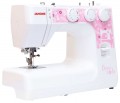Adjustments
—
Presser foot pressure adjustment. The ability to change the degree of pressure of the foot on the fabric, adjusting it to the thickness of the material: for thin fabrics (chiffon, knitwear), the pressure should be small, for thick ones — on the contrary.
—
Thread tension regulator. A device that allows you to adjust the degree of tension of the upper thread. A mismatch in tension between the top and bottom threads causes one of the threads to pull the other and the seam deteriorates. To avoid this phenomenon, this function is provided. Note that tension adjustment is also possible for the lower thread — it is carried out through the shuttle (all shuttles have this option). But for this, it is necessary to remove the bobbin case or even the entire shuttle. The top regulator is located directly on the body of the machine, and it is much easier to use it.
—
Puncture force stabilizer. A device that provides a stable puncture force regardless of the engine speed. A feature of the mechanics of electric motors is that without special adjustment, the puncture force decreases markedly with an increase in speed. This function allows you to maintain approximately the same level over the entire speed range, which has a positive effect on the quality of work.
—
Feed shutdown. Possibility to turn off the bottom feed of the
...machine. This feature is indispensable for work in which the fabric needs to be shifted manually — for example, embroidering along a complex contour on a typewriter without an embroidery unit, sewing on buttons, etc.
— Speed control. The ability to set a speed limit for the machine. Thanks to this function, you can not be afraid to "squeeze" the pedal — even with strong pressure, the machine will work at a given speed, and no faster. This feature is useful, in particular, in jobs where you need to carefully control the process.
— Knee lever. A device that allows you to raise the presser foot and lower the lower feed dog with a knee movement without removing your hands from the fabric. Such a device is useful for quilting and some types of embroidery.Presser foots
Types of presser feet supplied with the sewing machine.
— Universal foot. A foot is used for standard sewing, mainly straight stitches and zigzags.
—
Overlock foot. A foot designed for overlocking. By definition, it is found in devices with an overlock function (see “Type”). However, it can also be provided in traditional sewing machines. In the latter case, such a foot, of course, will not replace a full-fledged overlocker, but in some situations it allows you to work without it.
—
Top feed or walking foot. An additional top-mounted feed dog in place of the stock foot, in addition to the standard bottom feed dog. Such a device makes it easier to work with thin, delicate and sliding fabrics, as well as sewing together several layers of fabric: the material moves as evenly as possible, without distortions and displacements.
—
Zipper foot. The foot for sewing in a zipper can have a different size and design — in particular, there are special devices for sewing in a hidden zipper. The specific features of this device should be clarified separately.
—
Decorative stitch foot. Feet designed for various types of decorative stitching. Such a line may not have a functional role. Its main task is to emphasize a certain element of clothing (edges, pockets, individual seams, etc.). Anyway, the stit
...ch line should usually strictly follow the contour along which it is applied — and this contour can consist of both straight lines and curved lines. Special feet for decorative stitching simplify the task: they are equipped with rulers or other devices that allow you to control the parallelism of the stitches.
— Satin stitch foot. This foot will be suitable for appliqué and other work where zigzag stitches are often used.
— Blind hem foot. Foot designed for blind seams used when hemming the edge of the fabric. It is equipped with a device that provides a hem of the fabric and in this position feeds it under the needle.
— Quilting foot. Special feet for quilting — patchwork. In such works, it is necessary to sew the fabric in several layers, as well as to perform figured seams. In extreme cases, you can use the usual universal foot for quilting, but using a special device is still much more convenient.
— Monogramming foot. The foot for embroidery of monograms will allow you to make embroidery on any object, thereby decorating it with your signature or the emblem of any institution, company, or sports club.
— Buttonhole foot. Buttonhole foot. It eliminates the need for manual work. The sewing machine will do everything for you, which will reduce your time and please you with quality.
— Button sewing foot. A foot is designed to hold the button on the fabric while sewing on. It has a special protrusion pointing down: when the main part of the foot is pressed against the button, this protrusion presses the fabric and prevents it from slipping.
In addition to the above, other types of feet may be included in the delivery kit.Power consumption
The power consumed by the machine during operation. Usually, the maximum power value is indicated in the characteristics.
Most of the electricity supplied to the machine is consumed by the engine, so this indicator primarily describes the power of the engine. The higher this power, the faster the machine can work and the better it is suitable for working with dense fabrics. However, there is no strict dependence here, much also depends on the general specialization of the unit.

